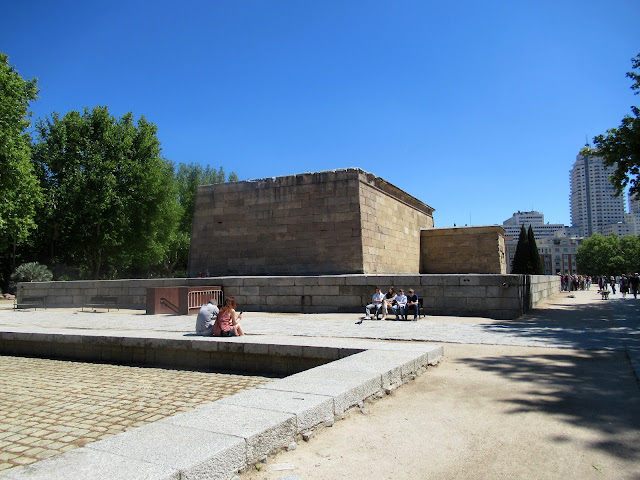The Capability Brown lake at Blenheim Palace.
Sunday, 30 June 2024
Thursday, 27 June 2024
Parque del Oste
We discovered Parque del Oste on the day we were doing our longest walk during our holiday in Madrid and we spent about an hour in this pleasant park.
Before the 20th century, the land that the park currently occupies was the main landfill of the city.
We started exploring the park.
quite a few people walking, but the park was still very peaceful
We then got a first glimpse of the Templo of Debod, an ancient Nubian temple that was dismantled as part of the International Campaign to Save the Monuments of Nubia and rebuilt in the centre of Madrid.
The shrine was originally erected 15 km south of Aswan in Nubia. In 1960, due to the constuction of the Aswan High Damn and the consequent threat posed by its reservoir to numerous monuments and archaeological sites, UNESCO made an international call to save this rich historical legacy. The temple was donated to Spain in 1968.
It constutes one of the few works of ancient Egyptian architecture that can be seen outside Egypt.
and wow! the biggest rose garden I have ever seen. La Rosaleda. By now we knew that the people here love rose gardens, but the scale of this one is phenomenal

The garden was designed by Ramon Ortiz and was completed in 1955. The park covers over 32,000 sswquare metres and houses more than 20,000 roses representing around 600 different varieties.
Once a year the Concurso Internacional de rosas nuevas Villa de Madrid, a competition for new roses, takes place. This event attracts rose breeders from around the world who showcase their latest varieties in hopes of receiving prestigious awards.
Ornamental ponds or fountains are dotted about
Each rose has a plaque informing us of the name, country and date of origin
At the edge of the garden is the cable car station - we were looking forward to going on this, but it's abandoned - from the looks of it, quite a while ago.
Tuesday, 25 June 2024
A simple, minimalist church
Built for the Discalced Carmelites the foundation stone was laid in 1916. The work of architect Jesus Carrasco-Munoz, the building was completed in 1928. Severely damaged during the Burning of the Convents in 1931, it was restored at the end of the Spanish Civil War.
The Apotheosis of Saint Teresa by Francisco Cossio

A really modern church created in an eclectic style that mixes elements from different architectural styles such as Gothic, Renaissance and Modernism. The result of such a strange combination is a construction that really looks like a Medieval Castle. This keeps with the best well known works of Saint Theresa, 'Moradas'. In it she conceived the christian soul like a diamond with the shape of a castle. This is why the church reminds us of a beautiful castle.
As you enter the simplicity of the interior is what hits you most. It was such a welcome after all the gilded, ornate, over-decorated churches we had visited in the last few days. The central part consists of a wide lowered half barrel vault.
The side naves are composed by broken arches which reflect the arches of the front entry.
The most remarkable decoration is the 19m reredo emplaced in the front part. In it a 4.5m statue of Saint Teresa can be found. Below her, a smaller statue of Saint Juan de la Cruz stands. The appearance of both saints in the front part is related to the real coexistence that they had when they made the reform of the Carmelitas religious order.
In the lateral parts of the reredo different saints can be found in wood. In the altar there is a table in which the 12 Apostles are represented.
On one side the door is this small chapel
its ceiling
and a closer look
one of the glass stained windows

The chapel on the other side of the door.
As we were leaving I thought that if I was religious and the praying kind, this is where I would like to go and pray.
Sunday, 23 June 2024
The palace gardens - Madrid
The chalet del Corcho was also very cute
the avenue that led to the palace
We retraced our steps so that we could walk under the plataneros again, and then continued on our way.
Subscribe to:
Comments (Atom)





















































